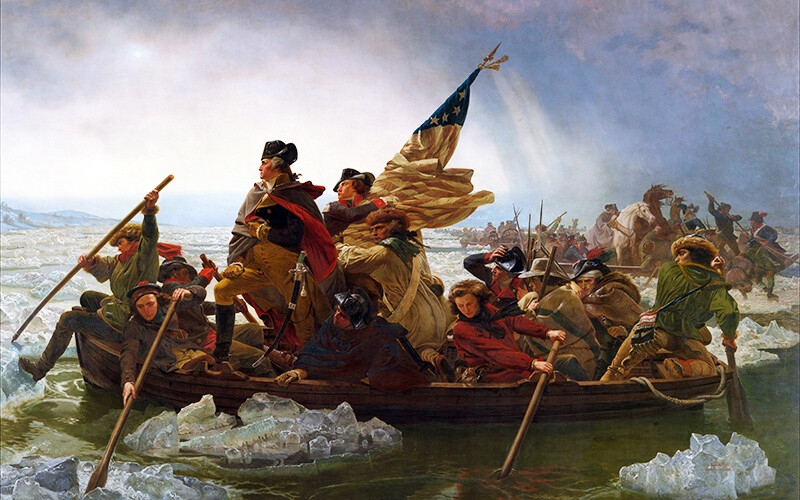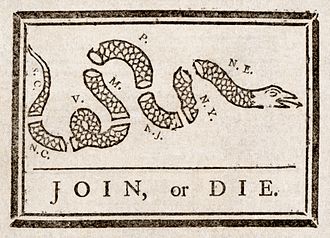Untold Facts about the American Revolution
The American Revolution was a struggle between 13 American colonies and Great Britain.
- The American colonies wished to attain independence and create a new sovereign nation – the United States.
- The American Revolutionary War lasted for eight years – between April 1775 to September 1783.
- The American colonists supporting independence were named Patriots.
- The American army was known as the Continental Army after the Continental Congress of 13 states.
- The 13 colonies were Delaware, Pennsylvania, New Jersey, Georgia, Connecticut, Massachusetts Bay, Maryland, South Carolina, New Hampshire, Virginia, New York, North Carolina, and Rhode Island.
- Colonists remaining loyal to the British crown were known as ‘loyalists’.
- British soldiers were known as ‘redcoats’ or ‘devils.’
- During the war, the majority of people living in the American colonies were ‘fence sitters’ not taking either side.
- The American Commander in Chief was George Washington.
- The British military commander at the start of Revolution was Sir William Howe, though he was later replaced due to failures in the British war effort.
- King George III led British resistance to American independence. The British Prime Minister was Lord North (a Tory)

- Not all British MPs supported military action against the American Patriots. The ‘Whig’ faction, e.g. Edmund Burke criticised military action to resolve the issue.
- During the war, African-American slaves served on both sides of the war. The British offered freedom to slaves who escaped their masters and served with loyalist forces. After 1776, George Washington raised a small number of black only units.
- During the chaos of war, many slaves were able to escape. In South Carolina, 30% of slaves escaped, migrated or died during the conflict.
- Approx 25,000 American Patriots died during military service – the biggest cause of death was disease – often in unsanitary prisoner of warships.
- Compared to the ratio of the population, The War of Independence was the second-deadliest American conflict after the Civil War.
- In 1776, the population of the 13 American colonies was estimated at 2.4 million. 85% of the white population was of British descent, with 9% of German origin and 4% Dutch.
- Approx 42,000 British sailors deserted in the war. American colonies also had difficulties raising troops due to the economic need to stay on a farm. 90% of the American population worked on farms.
- The British army was weakened by needing to also fight in the Caribbean.
Background to Revolution
- The Stamp Act (1765) required a tax on official documents to help raise revenue for Great Britain after the expensive British-French war of 1763. The tax was unpopular and created resentment against British rule from London.
- The Sons of Liberty was a secret society of people from the American colonies who wanted to protect the rights of colonists.
- Boston Massacre (1770): Four colonists protesting against custom laws were shot by British troops.
- Tea Act (1773) designed to help the East India Company unpopular in America.
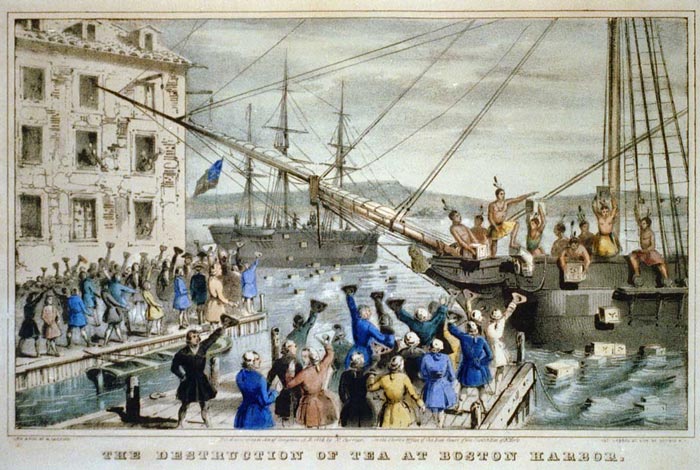
- Boston Tea Party. 16th December 1773. Boston colonists protested against the British Tea Act by raiding ships in Boston Harbour and dumping imported tea into the sea.
- Coercive Acts (1774) was a bill passed by British Parliament in response to the colonists’ rebellion in Boston. The acts sought to remove the power of the Massachusetts government. In America, they became known as the ‘Intolerable Acts’.
- 5 September 1774, Peyton Randolph was elected as first President of the Continental Congress in Philadelphia – a convention of delegates from different colonies.
- Peyton Randolph could claim to be America’s first president, though his job was largely ceremonial; it was a very different job to the first Presidency of George Washington.
- July 4, 1776 – The United States declared independence from Great Britain.
- The Declaration of Independence was written by Thomas Jefferson, who later became America’s third president.
- The first person to sign the Declaration of Independence was John Hancock the President of Congress.
The War of Independence
- The first battles of the war took place at Lexington and Concord. They were relatively minor skirmishes.
- The largest battle of the war took place on August 27, 1776. British troops gained control of New York. It is known as the Battle of Long Island and also the Battle of Brooklyn Heights.
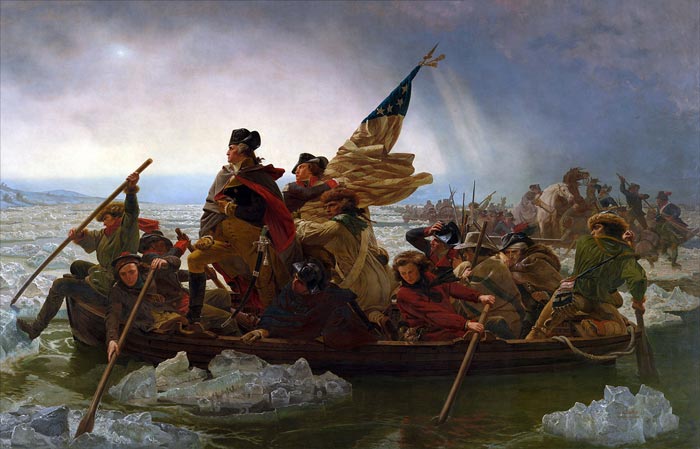 Washington Crossing the Delaware by Emanuel Leutze (1851)
Washington Crossing the Delaware by Emanuel Leutze (1851)
- On December 26, 1776, George Washington stealthily crossed the Delaware to attain a surprise victory over German troops in the Battle of Trenton. This small victory helped boost morale and turn the tide of war.
- The Continental Army used a system of “alarm and muster” to spread information about troop movements. These riders included people like silversmith, Paul Revere, who became a hero after warning of British troop movements.
- During the war American forces travelled to Quebec, hoping to spark an uprising against the British in Canada, but it failed.
- Due to the German connection of British King George III, one-third of British troops were German soldiers. (They became known as Hessian)
- In 1778, France formally entered the war against Great Britain, recognising the independence of the United States.
- Benjamin Franklin (a popular ambassador to France) was a major influence in encouraging the French King to supply troops, money and support to the American colonists.
- French generals like Marquis de Lafayette offered military advice to the new Continental Army.
- In 1779, Spain secretly joined the war as an ally of France and America, hoping to capture Gibraltar and British colonies in the Caribbean.
- In 1776, the position of the Continental Army was precarious with Washington’s army divided between two islands (Manhattan and Long Island). Despite the numerical superiority of the British Army, they missed the opportunity to finish off Washington’s Army.
- The Battle of Saratoga – Sep 19 to October 7, 1777 – was a major turning point in the war, with nearly 6,000 British troops surrendering.
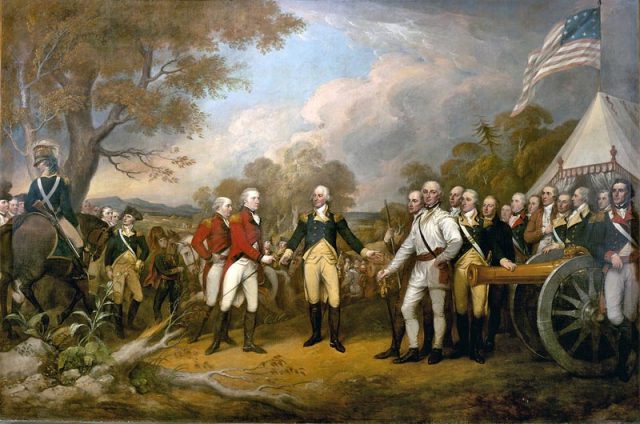
Surrender of General Burgoyne at Battle of Saratoga
SEE ALSO : Barack Obama Childhood Biography, life Story & Net worth
- Battle of Yorktown – the final major battle of the Revolutionary War from September 28 to October 19, 1781. George Washington’s army defeated the British army under Lord Cornwallis.
Women of the American Revolution
- Betsy Ross is credited with making the first American flag. Presenting the new flag to George Washington in 1776.
- Martha Washington the wife of George Washington toured camps with her husband and became the first ‘First Lady’ of the United States.
- Abigail Adams, the wife of John Adams, undertook a lengthy correspondence with her husband – writing support for the Independence movement and helping to recruit for the cause.
- Molly Pitcher served as water carrier to Patriot troops during battles. After the death of husband in battle, she took his place firing the artillery gun.
- Mercy Otis Warren from Massachusetts wrote poems and songs criticising British laws and encouraging colonists to stand up for their rights.
Great slogans of the American Revolution
“We hold these truths to be self-evident, that all men are created equal, that they are endowed by their Creator with certain unalienable Rights, that among these are Life, Liberty and the pursuit of Happiness. ”
Declaration of Independence July 4, 1776
“No taxation without representation”
This became a rallying cry for American colonists who resented these taxes to pay for British wars.
“Give me liberty, or give me death!”
A quotation attributed to Patrick Henry from a speech he made to the Second Virginia Convention on March 23, 1775
“Join, or Die”
– Benjamin Franklin – This was a political cartoon by Benjamin Franklin. First published in his Pennsylvania Gazette on May 9, 1754.
“We, therefore, the Representatives of the united States of America, in General Congress, Assembled, appealing to the Supreme Judge of the world for the rectitude of our intentions, do, in the Name, and by Authority of the good People of these Colonies, solemnly publish and declare, That these united Colonies are, and of Right ought to be Free and Independent States, that they are Absolved from all Allegiance to the British Crown, and that all political connection between them and the State of Great Britain, is and ought to be totally dissolved; and that as Free and Independent States, they have full Power to levy War, conclude Peace, contract Alliances, establish Commerce, and to do all other Acts and Things which Independent States may of right do.”
Declaration of Independence July 4, 1776
SEE ALSO : British woman was finally rescued 10 hours after falling off a cruise ship
Citation: Pettinger, Tejvan. “Facts about the American Revolution”, Oxford, www.biographyonline.net, 21st February 2017.
The American Revolution
 The American Revolution at Amazon
The American Revolution at Amazon
America – Teacher’s Edition
 America – Teacher’s Edition at Amazon
America – Teacher’s Edition at Amazon
Fact Check
We strive for accuracy and fairness. If you see something that doesn’t look right, contact us!
Thanks for reading and remember to share this post

